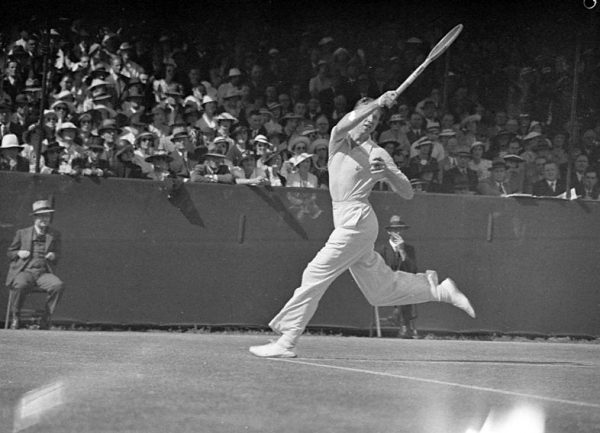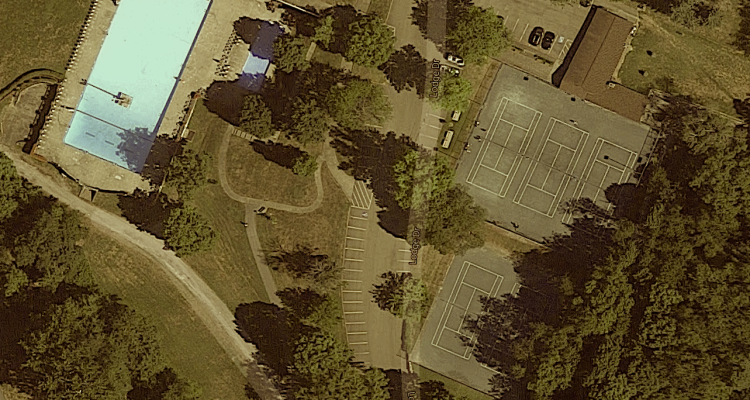The tennis courts four and five are gone. I drove through Crispin Center with my buddy Rory, a thoroughbred mutt a lot like the driver and saw the work in progress. There was a big commercial dumpster parked there into which the fencing, net posts, hard-true, and the original mud- clay were being loaded. The original light colored clay brought back memories of the mid forties in flashes. White tennis balls and wooden tennis rackets which were put into a waterproof cover after play to protect the gut strings from moisture. Then the covered head was slipped into a wooden press that was tightened down with wing nuts to keep the racket from warping into a twisted mess. The official attire was all white, collared shirt, shorts, socks and shoes ( some of the oldsters wore white trousers. I remember a Mr. Drennen who wore them). A tennis sweater, white cable knit with two bands of color around the V neck was common with the men.
In 1942 I got a job taking care of the tennis courts. There were five then, and Siggy Front, whom I was replacing, taught me the ropes. I reported on the appointed morning a bit early. I knew the first order of business was rolling the courts. I was filling the roller which was 2 to 2 1/2 feet in diameter and was 3 to 3 1/2 feet wide filled with water when Sig arrived and exclaimed “What are you doing?” I told him I was filling the roller which was almost empty. He told me to leave it that way, it was much easier to handle. We had to soak the courts with a hose in the evening. One had to spray enough water on them to turn the powdered clay, caused by the action on the courts, into a solid surface but not too much to make them muddy and unplayable the next morning. Once in a great while, I wouldn’t finish until after the last bus left the park at 9PM. I would call home and advise them that I would sleep in the tack room in the riding stable, where the tennis parking lot is now located. The outside wall in the tack room was alive with buzzing sounds during daylight hours. It housed a bee hive between the inside and outside walls. I will always remember Chester Kloss. He was the best at handling those big horses when they “acted up,” even though he had a bad leg and was on a crutch. He had very powerful arms. I believe he had polio as a child.
The first thing in the morning the courts had to be rolled. If you did it right the night before, there was still dampness and you could roll upon arrival. If the courts dried out too much then they got a light sprinkle, not too much, before being rolled. We rolled them from side to side which was less turns with that heavy monstrosity. When I finished rolling, I would mix the lime powder and water in the little rectangular metal cart with a small brush attached to the bottom rear of the cart onto which the lime mixture would slowly pour when the operator pulled a lever. This little contraption put the lines on the courts. There were wooden pegs on all the corners of the court and when you lined the courts you followed the string tied to nails in the pegs. On a busy day, the courts often had to be sprinkled and the lines redone at the back service and base lines. With the watering of the clay, the mixing of the lime, and lining the courts, one developed a certain set of skills. It was a long day.
And now the reason for all this unwanted detail on the care of real clay courts.
I received a call in early Spring, around 1946, when there were still no leaves on the trees. I was asked if I could get one of the tennis courts in shape for play on a certain day. I agreed to try, and I did.
I was waiting at the court when a couple of cars arrived with the players. I believe it was the Hugus and Hubbard bunch, and they had Mr. Don Budge, a great tennis player in the 30s. They had a laughing good time, taking turns playing mixed doubles, switching in and out with Budge being the constant player.

When they finished playing and were getting into their cars, Don Budge asked, “Who got this court in shape?” and someone said, “The kid over there.” Budge turned back and walked over to me and held out his hand and said “Congratulations, son, that court is as smooth as a baby’s ass.”
Years later, when he died (2000), a column on the editorial page of the Wall Street Journal paid tribute to this great athlete as a Gentleman Sportsman. I had never seen an article such as this on the editorial page, and I knew from a personal experience here in Wheeling that it was well deserved.
As my old buddy John Stirewalt used to say about people of this caliber, “Those were the days when ships were made of wood and men were made of steel.”




